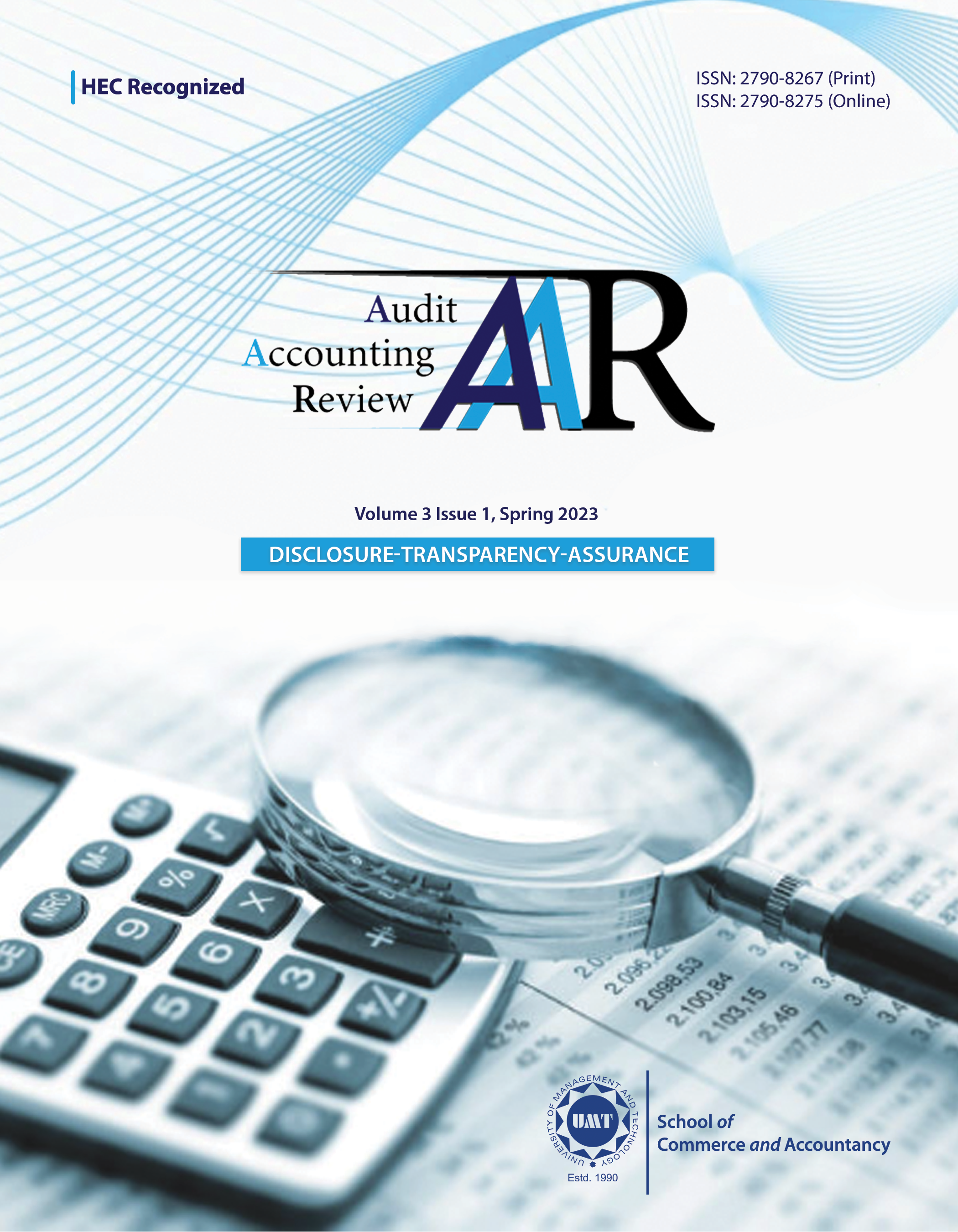Exploring Asymmetric Linkages and Volatility Transmission between Stock Market and Foreign Exchange (FOREX)
Abstract
 Abstract Views: 5
Abstract Views: 5
This study examines the direction and nature of volatility transmission between the stock market and the foreign exchange market (FOREX) of Pakistan. For this purpose, daily data is gathered to conduct the analysis for both markets. Stock market returns are measured by using the KSE-100 index and the daily Pakistan Rupee-PKR to the United States Dollar-USD exchange rate is used for the foreign exchange market. Noticeably, both the variables are stationary at their first difference. Normality is examined through Skewness and Kurtosis, Autocorrelation through Correlogram Q-statistics, and the ARCH effect through the ARCH-LM test. Volatility transmission between the two markets is examined by using bivariate diagonal BEKK-GARCH and bivariate E-GARCH models. The results of the study indicate that bi-directional volatility transmission exists between the stock market and the foreign exchange market (FOREX) of Pakistan. Results from the E-GARCH model further indicate that the nature of volatility transmission between these two markets is asymmetric, which means bad news of one market has a greater impact on the volatility of another market than the good news. Hence, the results of this study also indicate that past variances of the stock market and foreign exchange market has a significant effect on their own current volatility.
Downloads
References
Abbas, H., & Pasha, F. (2011). Financial liberalization and twin crises: Banking and balance of payments problems in Pakistan (Paper presentation). Twin Crises International Research Conference. Sri Lanka. https://www.cbsl.gov.lk/sites/default/files/Twin_Crises_Full.pdf
Ahmedi, R., Rezayi, M., & Zakeri, M. (2012). Effect of exchange rate exposure on stock market: Evidence from Iran. Middle-East Journal of Scientific Research, 11(5), 610–616. https://www.idosi.org/mejsr/mejsr11(5)12/11.pdf
Akbar, M., Iqbal, F., & Noor, F. (2019). Bayesian analysis of dynamic linkages among gold price, stock prices, exchange rate and interest rate in Pakistan. Resources Policy, 62, 154–164. https://doi.org/10.1016/j.resourpol.2019.03.003
Azman-Saini, W., Habibullah, M. S., & Azali, M. (2003). Stock price and exchange rate dynamics: Evidence from Thailand. Savings and Developments, 27(3) 245–258. https://www.jstor.org/stable/25830830
Branson, W., Halttunen, H., & Masson, P. (1977). Exchange rate in short run : The dollar deutche mark rate. European Economic Review, 10(3), 303–324. https://doi.org/10.1016/S0014-2921(77)80002-0
Bukhari, I. H. (2013). Social relationship between exchange rate and stock prices, a case on SAARC economies. Academy of Contemporary Research Journal, 7(4), 175–181.
Daniel, F. C., Victor, F., & Tian, Y. F. (2009). Volatility spillovers between New Zealand stock market returns and exchange rate changes before and after the 1997 financial crises. Asian Journal of Accounting and Finance, 1, 106–117. http://hdl.handle.net/10536/DRO/DU:30042539
Dornbusch, R., & Fischer, S. (1980). Exchange rates and current accounts. American Economic Review, 5, 960–971. https://www.jstor.org/stable/1805775
Dorubusch, R. (1976). Expectations at exchange rate dynamics. Journal of Political Economy, 84(6), 1161–1176. https://doi.org/10.1086/260506
Dua, P., & Tuteja, D. (2016). Financial crises and dynamic linkages across international stock and currency markets. Economic Modelling, 59(1), 249–261. https://doi.org/10.1016/j.econmod.2016.07.013
Ebrahim, S. K. (August, 2000). Volatility transmission between foreign exchange and money markets (Bank of Canada Staff Working Paper No. 2000-16). https://www.bankofcanada.ca/2000/08/working-paper-2000-16/
Frankel, J., & Rodriguez, C. (1975). Portfolio equibrium and the balance of payments: A monetary approach. American Economic Review, 65(4), 674–688. https://www.jstor.org/stable/1806543
Hakim, A., & McAleer, M. (2009). Modeling the interactions across international stock, bond and foreing exchange markets. Applied Economics, 42(7), 825–850. https://doi.org/10.1080/00036840701720994
Hanif, M. (2020). Relationship between oil and stock markets: Evidence from Pakistan Stock Exchange. International Journal of Energy Economics and Policy, 10(5), 150–157. https://doi.org/10.32479/ijeep.9653
He, X., Gokmenoglu, K., Kirikkaleli, D., & Rizvi, S. K. (2021). Co-movement foreign exchange rate returns and stock market returns in an emerging market: Evidence from the wavelet coherecnce approach . International Journal of Finance and Economics, 28(2), 1994–2005. https://doi.org/10.1002/ijfe.2522
Horobet, A., & Ilie, L. (2007). On the dynamic link between stock prices and exchange rates: Evidence from Romania. Munich Personal RePEc Archive, Article e6429. https://mpra.ub.uni-muenchen.de/6429/1/MPRA_paper_6429.pdf
Khalid, A. M., & Rajaguru, G. (2006). Financial market integration in pakistan evidence using post-1999 data. The Pakistan Development Review, 45(4), 1041–1053. https://www.jstor.org/stable/41260667
Koutmos, G., & Booth, G. G. (1995). Asymmetric volatility transmission in international stock market. Journal of Money and International Finance, 14(6), 747–762. https://doi.org/10.1016/0261-5606(95)00031-3
Doong, S.-C. Lee, C.-H., , & Chou, P.-l. (2011). Dynamic correlation between stock prices and exchange rates. Applied Financial Economics, 21(11), 789–800. https://doi.org/10.1080/09603107.2010.537631
Liu , Y., Qiao, T., & Han, L. (2022). Does clean energy matter? Revisiting the spillovers between energy and foreign exchange markets . Journal of Futures Market, 42(11), 2068–2083. https://doi.org/10.1002/fut.22340
Luo, J., & Wang, S. (2019). The asymmetric high-frequency volatility transmission across international stock markets. Finance Research Letters, 31, 104–109. https://doi.org/10.1016/j.frl.2019.04.025
Mustafa, K., & Nishat, M. (2008). Exchange rate and equity prices relationship: An empirical evidence from Pakistani financial markets. Savings and Development, 32(2), 127–140. https://www.jstor.org/stable/25830973
Naeem, M., & Rasheed, A. (2002). Stock prices and exchange rates: Are they related? Evidence from South Asian countries. The Pakistan Development Review, 41(4), 535–550. https://www.jstor.org/stable/41263367
Narayan, K. P., Devpura, N., & Wang, H. (2020). Japanese currency and stock market-What happened during the COVID-19 pandemic? Economic Analysis and Policy, 68, 191–198. https://doi.org/10.1016/j.eap.2020.09.014
Naseem, S., Fu, G. L., Thilan, V., Mohsin, M., & Zia-ur Rehman, M. (2019). Macroeconomic variables and the Pakistan Stock Market: Exploring long and short-run relationship. Public Business Review International. 11(7), 62–72.
Nieh, C., & Lee, C. (2001). Dynamic relationship between stock prices and exchange rate for G-7 countries. Quarterly Review of Economics and Finance, 41(4). 477–490. https://doi.org/10.1016/S1062-9769(01)00085-0
Noman, A. M., Kabir, S. H., & Bashar, O. K. (2012). Causality between stock and foreign exchange market of Bangladesh. Studies and Economics and Finance, 29(3),174–186. https://doi.org/10.1108/10867371211246849
Qayyum, A., & Kemal, A. (2006). Volatility spillover between the stock market and the foreign exchange market in Pakistan (Pakistan Institute of Development Economics Working Paper). https://tinyurl.com/4ya99kzr
Rehan , R., Zehra, I., Chhapra, I. U., & Makhija, P. (2019). The relationship between exchange rate and stock prices in South Asian countries. International Journal of innovationn, Creativity and Change, 6(9), 113–135.
Rehman, M. L., & Uddin, J. (2009). Dynamic relationship between stock prices and exchange rates: Evidence from three SouthAsian countries. International Business Research, 2(2), 167–174. https://doi.org/10.5539/ibr.v2n2p167
Singhal, S., Choudhary, S., & Biswal, P. C. (2019). Return and volatility linkages among international crude oil price, gold price, exchange rate and stock markets: Evidence from Mexico. Resources Policy, 60, 255–261. https://doi.org/10.1016/j.resourpol.2019.01.004
Wai-Choi Lee. (2012). A study of causal relationship between real exchange rate of renminbi and Hong Kong stock market index. Modern Economy, 3(5), 563–566. http://dx.doi.org/10.4236/me.2012.35074
Wei, C. (2009). Using the component GARCH modelling and forecasting method to determine the effect unexpected exchange rate mean and volatility spillover on stock market. International Research Journal of Finance and Economics, 1(23), 62–74.
Wei, Y., Qin, S., Li, X., Zhu, S., & Wei, G. (2019). Oil price fluctuation, stock market and macroeconomic fundamentals: Evidence from China before and after the financial crises. Finance Research Letters, 30, 23–29. https://doi.org/10.1016/j.frl.2019.03.028
Yang, S., & Doong, S. (2004). Price and volatility spillover between stock price and exchange rates: Evidence from the G-7 countries. International Journal of Business and Economics, 3(2), 139–153.
Zhao, H. (2009). Dynamic relationship between exchange rate and stock prices: Evidence from China. Research In International Business and Finance, 24(2), 103–112. https://doi.org/10.1016/j.ribaf.2009.09.001
Zia, Q. Z., & Rahman, Z. (2011). The causality between stock market and foreign exchange market of Pakistan. Interdisciplinary Journal of Contemporary research In Business, 3(5), 906–919.
Copyright (c) 2023 Ghulam Mustafa

This work is licensed under a Creative Commons Attribution 4.0 International License.
Authors retain copyright and grant the journal right of first publication with the work simultaneously licensed under a Creative Commons Attribution (CC-BY) 4.0 License that allows others to share the work with an acknowledgement of the work’s authorship and initial publication in this journal.







